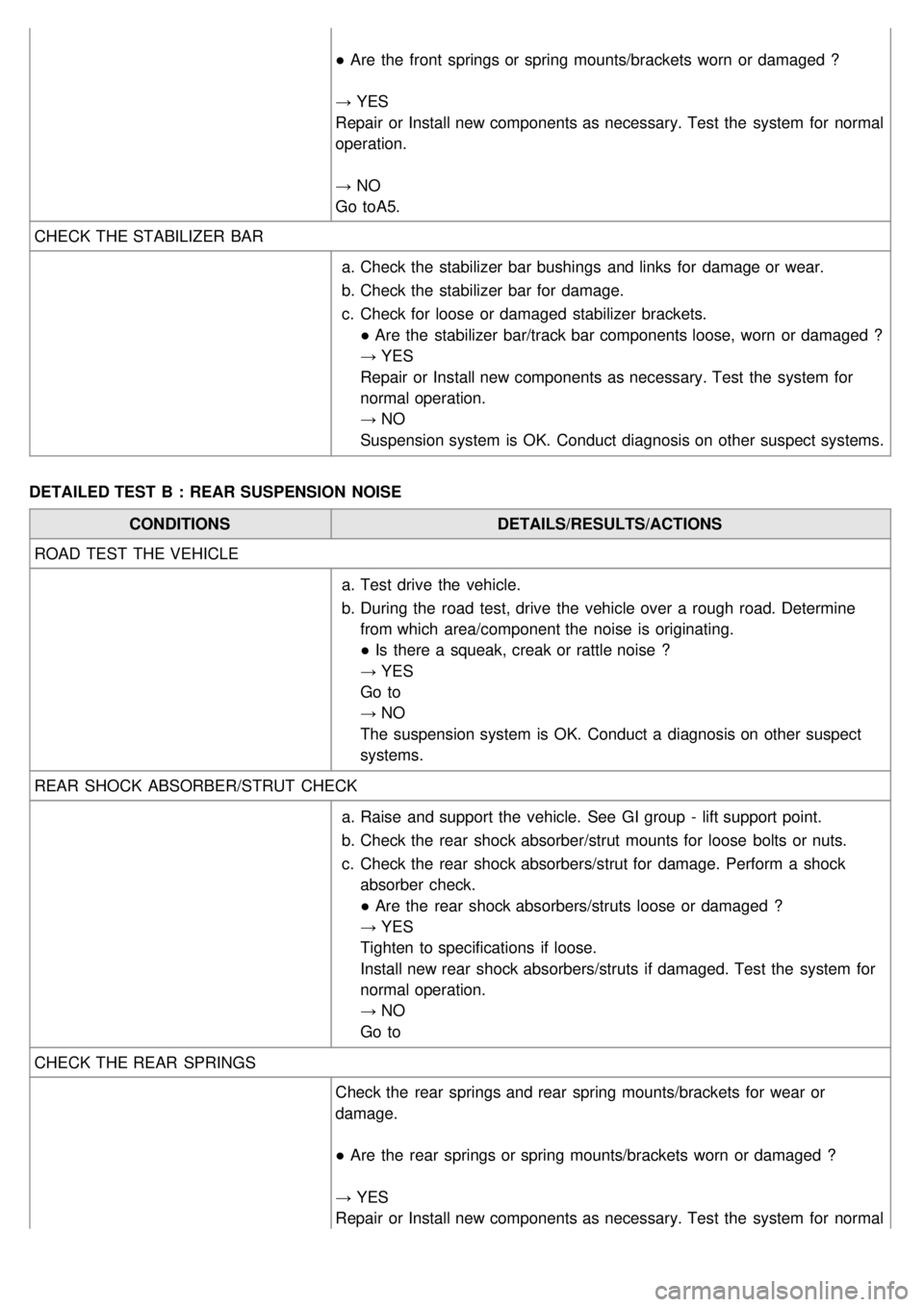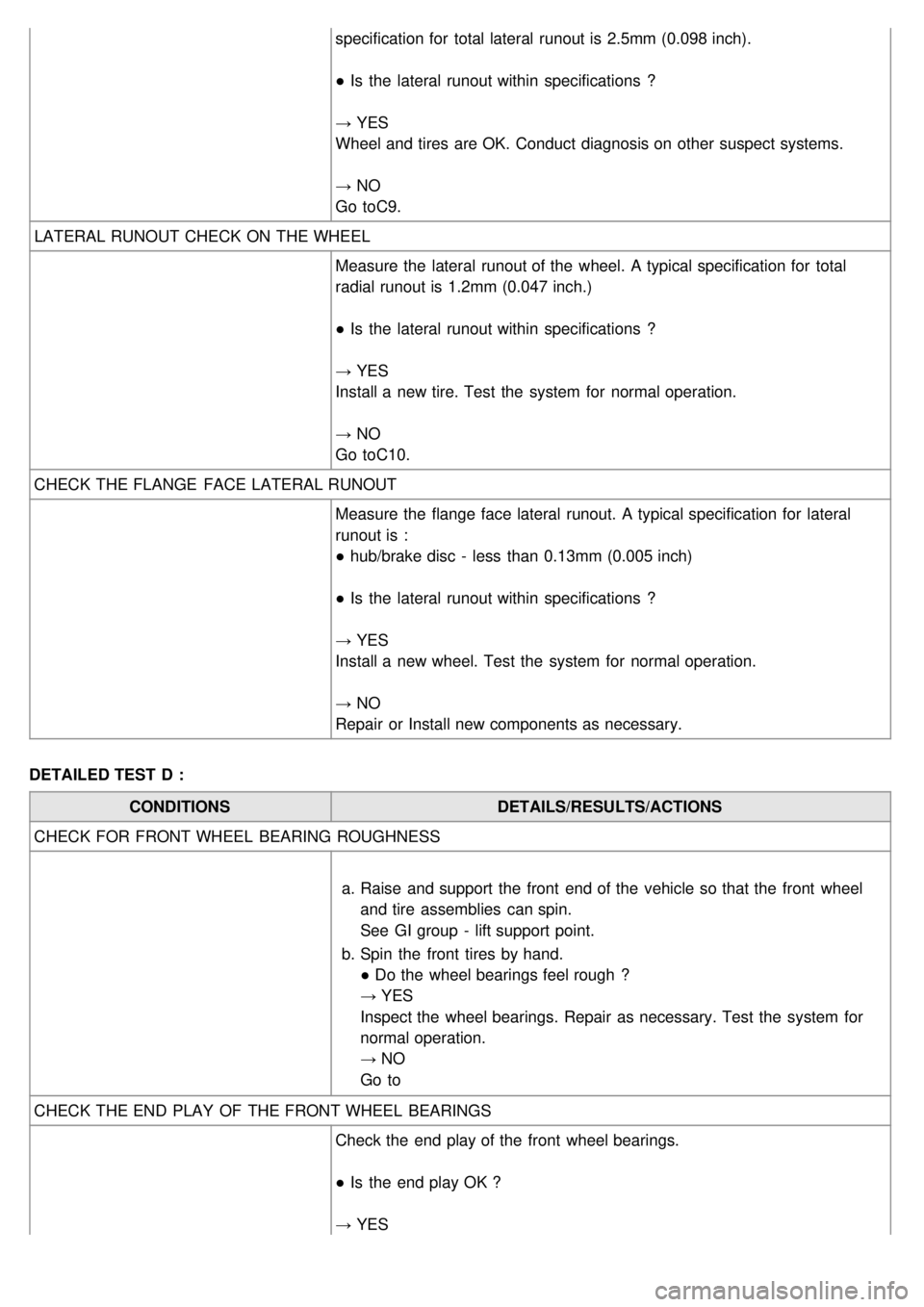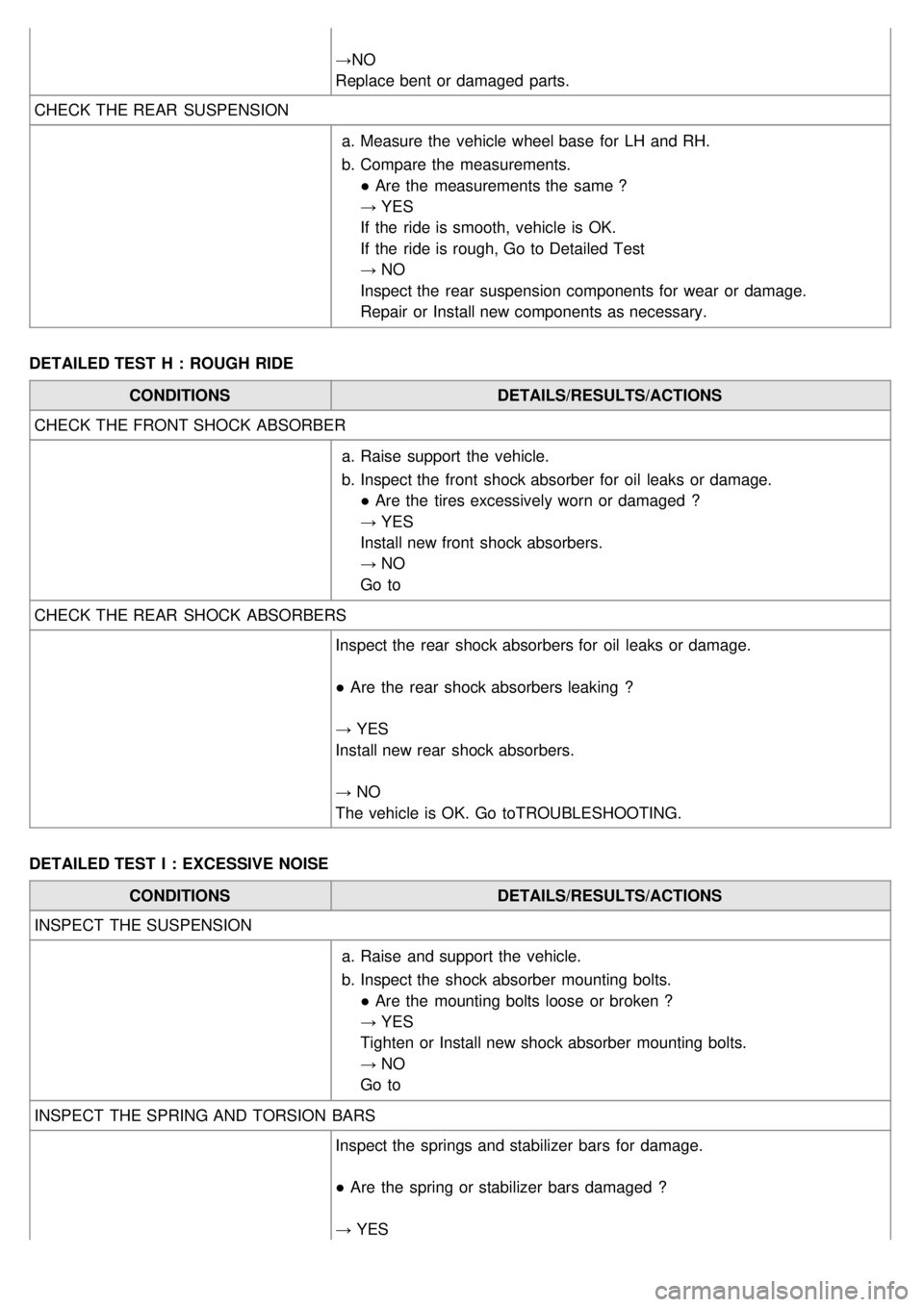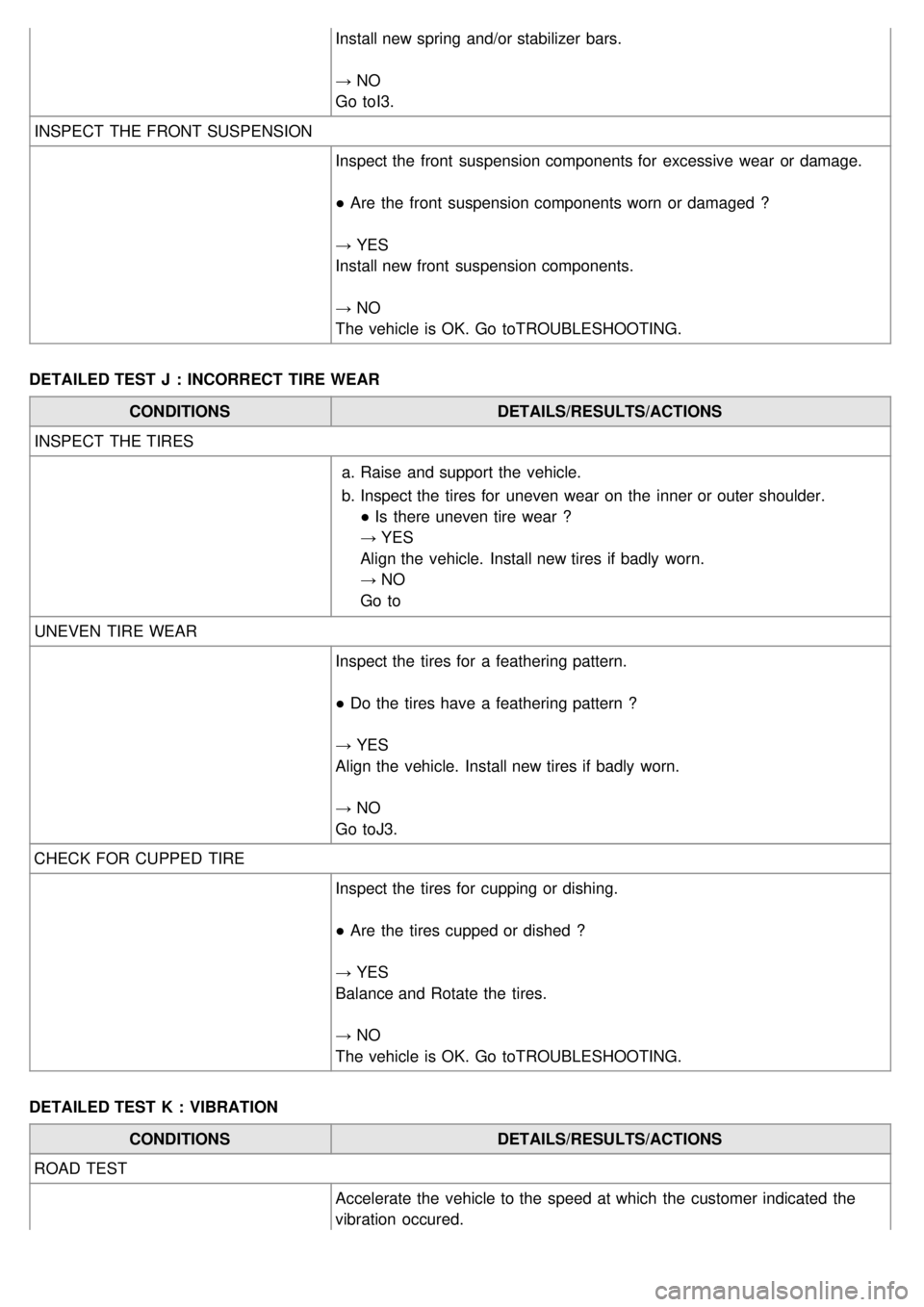KIA CARNIVAL 2007 Workshop Manual
Manufacturer: KIA, Model Year: 2007, Model line: CARNIVAL, Model: KIA CARNIVAL 2007Pages: 1575, PDF Size: 44.86 MB
Page 491 of 1575

● Are the front springs or spring mounts/brackets worn or damaged ?
→ YES
Repair or Install new components as necessary. Test the system for normal
operation.
→ NO
Go to A5.
CHECK THE STABILIZER BAR
a.Check the stabilizer bar bushings and links for damage or wear.
b. Check the stabilizer bar for damage.
c. Check for loose or damaged stabilizer brackets.
● Are the stabilizer bar/track bar components loose, worn or damaged ?
→ YES
Repair or Install new components as necessary. Test the system for
normal operation.
→ NO
Suspension system is OK. Conduct diagnosis on other suspect systems.
DETAILED TEST B : REAR SUSPENSION NOISE CONDITIONS DETAILS/RESULTS/ACTIONS
ROAD TEST THE VEHICLE
a.Test drive the vehicle.
b. During the road test, drive the vehicle over a rough road. Determine
from which area/component the noise is originating.
● Is there a squeak, creak or rattle noise ?
→ YES
Go to
→ NO
The suspension system is OK. Conduct a diagnosis on other suspect
systems.
REAR SHOCK ABSORBER/STRUT CHECK a.Raise and support the vehicle. See GI group - lift support point.
b. Check the rear shock absorber/strut mounts for loose bolts or nuts.
c. Check the rear shock absorbers/strut for damage. Perform a shock
absorber check.
● Are the rear shock absorbers/struts loose or damaged ?
→ YES
Tighten to specifications if loose.
Install new rear shock absorbers/struts if damaged. Test the system for
normal operation.
→ NO
Go to
CHECK THE REAR SPRINGS Check the rear springs and rear spring mounts/brackets for wear or
damage.
● Are the rear springs or spring mounts/brackets worn or damaged ?
→ YES
Repair or Install new components as necessary. Test the system for normal
operation.
Page 492 of 1575

operation.
→ NO
Go toB4.
CHECK THE TRAILING ARMS
a.Inspect the trailing arm bushings for wear or damage. Check for loose
trailing arm bolts.
b. Inspect for twisted or bent trailing arms.
● Are the trailing arms loose, damaged or worn ?
→ YES
Repair or Install new components as necessary. Test the system for
normal operation.
→ NO
Suspension system is OK. Conduct diagnosis on other suspect systems.
DETAILED TEST C : WHEEL AND TIRE CONDITIONS DETAILS/RESULTS/ACTIONS
ROAD TEST THE VEHICLE
Wheel or tire vibrations felt in the steering wheel are most likely related
to the front wheel or tire. Vibration felt through the seat are most likely
related to the rear wheel or tire. This may not always be true, but it can
help to isolate the problem to the front or rear of the vehicle.
Test drive the vehicle at different speed ranges.
During the road test, if the vibration can be eliminated by placing the
vehicle in neutral or is affected by the speed of the engine, the cause is not
the wheels or tires.
● Is there a vibration and noise ?
→ YES
Go to C2.
→ NO
The wheel and tires are OK. Conduct a diagnosis on other suspect
systems.
CHECK THE FRONT WHEEL BEARINGS Check the front wheel bearings.
Refer to Wheel Bearing Check (See DS group - front axle).
● Are the wheel bearings OK ?
→ YES
Go to C3.
→ NO
Inspect the wheel bearings. Adjust or Repair as necessary. Test the system
for normal operation.
INSPECT THE TIRES
a.Check the tires for missing weights.
b. Check the wheels for damage.
Page 493 of 1575

c.Inspect the tire wear pattern.
● Do the tires have an abnormal wear pattern ?
→ YES
Correct the condition that caused the abnormal wear. Install new tire(s).
Test the system for normal operation.
→ NO
Go to
TIRE ROTATION DIAGNOSIS a.Spin the tires slowly and watch for signs of lateral runout.
b. Spin the tires slowly and watch for signs of radial runout.
● Are there signs of visual runout ?
→ YES
Go to
→ NO
Check the wheel and tire balance.
Correct as necessary. Test the system for normal operation.
RADIAL RUNOUT CHECK ON THE TIRE Measure the radial runout of the wheel and tire assembly. A typical
specification for total radial runout is 1.15mm (0.059 inch).
● Is the radial runout within specifications ?
→ YES
Go to C8.
→ NO
Go to C6.
RADIAL RUNOUT CHECK ON THE WHEEL Measure the radial runout of the wheel. A typical specification for total radial
runout is 1.14mm (0.045 inch.).
● Is the radial runout within specifications ?
→ YES
Install a new tire. Test the system for normal operation.
→ NO
Go to C7.
CHECK THE HUB/BRAKE DISC OR DRUM PILOT RUNOUT OR BOLT CIRCLE RUNOUT Measure the pilot or bolt circle runout. A typical specification for radial
runout is :
● pilot runout - less than 0.15mm (0.006 inch.)
● bolt circle runout - less than 0.38 mm (0.015 inch.)
● Is the radial runout within specification ?
→ YES
Install a new wheel. Test the system for normal operation.
→ NO
Repair or Install new components as necessary.
LATERAL RUNOUT CHECK ON THE TIRE Measure the lateral runout of the wheel and tire assembly. A typical
specification for total lateral runout is 2.5mm (0.098 inch).
Page 494 of 1575

specification for total lateral runout is 2.5mm (0.098 inch).
● Is the lateral runout within specifications ?
→ YES
Wheel and tires are OK. Conduct diagnosis on other suspect systems.
→ NO
Go to C9.
LATERAL RUNOUT CHECK ON THE WHEEL Measure the lateral runout of the wheel. A typical specification for total
radial runout is 1.2mm (0.047 inch.)
● Is the lateral runout within specifications ?
→ YES
Install a new tire. Test the system for normal operation.
→ NO
Go to C10.
CHECK THE FLANGE FACE LATERAL RUNOUT Measure the flange face lateral runout. A typical specification for lateral
runout is :
● hub/brake disc - less than 0.13mm (0.005 inch)
● Is the lateral runout within specifications ?
→ YES
Install a new wheel. Test the system for normal operation.
→ NO
Repair or Install new components as necessary.
DETAILED TEST D : CONDITIONS DETAILS/RESULTS/ACTIONS
CHECK FOR FRONT WHEEL BEARING ROUGHNESS
a.Raise and support the front end of the vehicle so that the front wheel
and tire assemblies can spin.
See GI group - lift support point.
b. Spin the front tires by hand.
● Do the wheel bearings feel rough ?
→ YES
Inspect the wheel bearings. Repair as necessary. Test the system for
normal operation.
→ NO
Go to
CHECK THE END PLAY OF THE FRONT WHEEL BEARINGS Check the end play of the front wheel bearings.
● Is the end play OK ?
→ YES
Go to D3.
Page 495 of 1575

Go toD3.
→ NO
Adjust or Repair as necessary. Test the system for normal operation.
MEASURE THE LATERAL RUNOUT AND THE RADIAL RUNOUT OF THE FRONT WHEELS ON THE VEHICLE Measure the lateral runout and the radial runout of the front wheels on the
vehicle. Go to detailed test C.
● Are the measurements within specifications ?
→ YES
Go to D4.
→ NO
Install new wheels as necessary and Balance the assembly. Test the
system for normal operation.
MEASURE THE LATERAL RUNOUT OF THE FRONT TIRES ON THE VEHICLE Measure the lateral runout of the front tires on the vehicle. Go to detailed
test C.
● Is the runout within specifications ?
→ YES
Go to D5.
→ NO
Install new tires as necessary and Balance the assembly. Test the system
for normal operation.
MEASURE THE RADIAL RUNOUT OF THE FRONT TIRES ON THE VEHICLE Measure the radial runout of the front tires on the vehicle. Go to detailed
test C.
● Is the runout within specifications ?
→ YES
Balance the front wheel and tire assemblies. If any tire cannot be balanced,
Install a new tire. Test the system for normal operation.
→ NO
Go to D6.
MATCH MOUNT THE TIRE AND WHEEL ASSEMBLY Mark the high runout location on the tire and also on the wheel. Break the
assembly down and rotate the tire 180 degrees (halfway around) on the
wheel. Inflate the tire and measure the radial runout.
● Is the runout within specifications ?
→ YES
Balance the assembly. Test the system for normal operation.
→ NO
If the high spot is not within 101.6mm (4 inches) of the first high spot on
the tire, Go to D7.
MEASURE THE WHEEL FLANGE RUNOUT
Page 496 of 1575

Dismount the tire and mount the wheel on a wheel balancer. Measure the
runout on both wheel flanges. Go to detailed test C
● Is the runout within specifications ?
→ YES
Locate and Mark the low spot on the wheel. Install the tire, matching the
high spot on the tire with the low spot on the wheel. Balance the assembly.
Test the system for normal operation. If the condition persists, Go to D8.
→ NO
Install a new wheel. Check the runout on the new wheel. If the new wheel
is within limits, locate and Mark the low spot. Install the tire, matching the
high spot on the tire with the low spot on the wheel. Balance the assembly.
Test the system for normal operation. If the condition persists, Go to D8.
CHECK FOR VIBRATION FROM THE FRONT OF THE VEHICLE Spin the front wheel and tire assemblies with a wheel balancer while the
vehicle is raised on a hoist. Feel for vibration in the front fender or while
seated in the vehicle.
● Is the vibration present ?
→ YES
Substitute known good wheel and tire assemblies as necessary.
Test the system for normal operation.
→ NO
Check the driveline components. Test the system for normal operation.
DETAILED TEST E : DRIFT LEFT OR RIGHT CONDITIONS DETAILS/RESULTS/ACTIONS
CHECK THE TIRES Inspect the tires for excessive wear or damage.
● Are the tires excessively worn or damaged ?
→ YES
Install new tires.
→ NO
Go to E2.
CHECK THE STEERING LINKAGE
a.Raise and support the vehicle.
b. Check the steering components for indications of excessive wear or
damage.
See ST group - specification.
● Is there an indication of excessive wear or damage ?
→ YES
Repair or Install new components as necessary.
→ NO
Go to
CHECK THE VEHICLE ALIGNMENT a.Place the vehicle on an alignment rack.
Page 497 of 1575

Check the vehicle alignmnt.
● Is the alignment within specification ?
→ YES
Go to
→ NO
Adjust the alignment as necessary.
See page SS - 69 (wheel alignment).
BRAKE DRAG DIAGNOSIS Apply the brakes while driving.
● Does drift or pull occur when the brakes are applied ?
→ YES
See BR group - specification.
→ NO
If the steering wheel is in the center, the vehicle is OK.
If the steering wheel is off- center, Go to Detailed Test F.
DETAILED TEST F : STEERING WHEEL OFF- CENTER CONDITIONS DETAILS/RESULTS/ACTIONS
CHECK THE CLEAR VISION Place the vehicle on an alignment rack.
● Is the clear vision within specification ?
→ YES
Go to F2.
→ NO
Adjust the clear vision to specification.
INSPECT THE STEERING COMPONENTS
a.Raise and support the vehicle.
b. Inspect the steering components for excessive wear or damage.
See ST group - specification.
● Are the steering components excessively worn or damaged ?
→ YES
Repair or Install new components as necessary.
→ NO
If it tracks correctly, vehicle is OK.
If it tracks incorrectly, Go to Detailed Test
DETAILED TEST G : TRACKS INCORRECTLY CONDITIONS DETAILS/RESULTS/ACTIONS
CHECK THE CASTER Place the vehicle on an alignment rack.
● Is the caster within specification ?
→ YES
Go to G2.
Page 498 of 1575

→NO
Replace bent or damaged parts.
CHECK THE REAR SUSPENSION
a.Measure the vehicle wheel base for LH and RH.
b. Compare the measurements.
● Are the measurements the same ?
→ YES
If the ride is smooth, vehicle is OK.
If the ride is rough, Go to Detailed Test
→ NO
Inspect the rear suspension components for wear or damage.
Repair or Install new components as necessary.
DETAILED TEST H : ROUGH RIDE CONDITIONS DETAILS/RESULTS/ACTIONS
CHECK THE FRONT SHOCK ABSORBER
a.Raise support the vehicle.
b. Inspect the front shock absorber for oil leaks or damage.
● Are the tires excessively worn or damaged ?
→ YES
Install new front shock absorbers.
→ NO
Go to
CHECK THE REAR SHOCK ABSORBERS Inspect the rear shock absorbers for oil leaks or damage.
● Are the rear shock absorbers leaking ?
→ YES
Install new rear shock absorbers.
→ NO
The vehicle is OK. Go to TROUBLESHOOTING.
DETAILED TEST I : EXCESSIVE NOISE CONDITIONS DETAILS/RESULTS/ACTIONS
INSPECT THE SUSPENSION
a.Raise and support the vehicle.
b. Inspect the shock absorber mounting bolts.
● Are the mounting bolts loose or broken ?
→ YES
Tighten or Install new shock absorber mounting bolts.
→ NO
Go to
INSPECT THE SPRING AND TORSION BARS Inspect the springs and stabilizer bars for damage.
● Are the spring or stabilizer bars damaged ?
→ YES
Install new spring and/or stabilizer bars.
Page 499 of 1575

Install new spring and/or stabilizer bars.
→ NO
Go toI3.
INSPECT THE FRONT SUSPENSION Inspect the front suspension components for excessive wear or damage.
● Are the front suspension components worn or damaged ?
→ YES
Install new front suspension components.
→ NO
The vehicle is OK. Go to TROUBLESHOOTING.
DETAILED TEST J : INCORRECT TIRE WEAR CONDITIONS DETAILS/RESULTS/ACTIONS
INSPECT THE TIRES
a.Raise and support the vehicle.
b. Inspect the tires for uneven wear on the inner or outer shoulder.
● Is there uneven tire wear ?
→ YES
Align the vehicle. Install new tires if badly worn.
→ NO
Go to
UNEVEN TIRE WEAR Inspect the tires for a feathering pattern.
● Do the tires have a feathering pattern ?
→ YES
Align the vehicle. Install new tires if badly worn.
→ NO
Go to J3.
CHECK FOR CUPPED TIRE Inspect the tires for cupping or dishing.
● Are the tires cupped or dished ?
→ YES
Balance and Rotate the tires.
→ NO
The vehicle is OK. Go to TROUBLESHOOTING.
DETAILED TEST K : VIBRATION CONDITIONS DETAILS/RESULTS/ACTIONS
ROAD TEST Accelerate the vehicle to the speed at which the customer indicated the
vibration occured.
Page 500 of 1575

● Is the vibration present ?
→ YES
Go to K2.
→ NO
The vehicle is OK. Go to TROUBLESHOOTING.
INSPECT THE TIRES
a.Raise and support the vehicle with a frame contact hoist.
b. Inspect the tires for extreme wear or damage, cupping, or flat spots.
● Are the tires OK ?
→ YES
Go to
→ NO
Check the suspension components for misalignment, abnormal wear, or
damage that may have contributed to the tire wear.
Correct the suspension concerns and Install new tires.
INSPECT THE WHEEL BEARINGS Spin the tires by hand to check for wheel bearing rougness.
● Is the front wheel bearing OK ?
→ YES
Go to K4.
→ NO
Install new front wheel bearings as necessary.
See Ds group - front axle.
TIRE/WHEEL BALANCE Check the tire/wheel balance.
● Are the tires balanced ?
→ YES
Go to K5.
→ NO
Balance the tires and wheels as necessary.
MEASURE THE RUNOUTS For each wheel position measure, locate and mark the following items.
- High point of the tire/wheel assembly total radial runout
- High point of the wheel radial runout
- High point of the wheel lateral runout
● Are the runouts as specified ?
→ YES
Go to K7.
→ NO
Go to K6.
SUBSTITUTE THE WHEELS AND TIRE